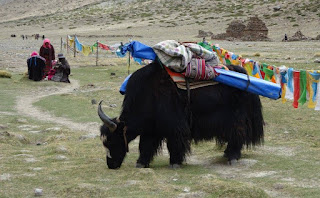[English below] Llegué a Kirguistán con la idea de comprar una motito y recorrer la mítica Pamir Highway, conocida como la segunda carretera más alta del mundo -después de la Karakorum Highway en Pakistán, para lo que se necesita la visa desde España-, pero a estas alturas de mi viaje mi economía no estaba como para muchos dispendios, así que cambié mis planes o, más bien, me quedé sin planes. Por tanto, me surgió la pregunta: "Y ahora... qué puedo hacer en Kirguistán??????"
Me pareció un buen plan buscar la respuesta mientras disfrutaba de la veraniega costa del lago Issyk Kul. De camino conocí a Temirlan. Un chico de Kirguistán que sin conocerme de nada me invitó a su casa. Me recordó a la desbordante hospitalidad Iraní, donde aprendí a confiar pese a los recelos y miedos que uno arrastra. Así que acepté su invitación y tras una semana de relax en las playas del lago, acabé teniendo el privilegio de asistir a una boda. Toda una inmersión cultural y gastronómica!!
Decidí seguir camino hacia las montañas del este, hacia Karakol, que supone un destino esencial de trekking en Kirguistán, con caminatas desde fáciles de un día hasta trekking exigentes de varios días, Alojado en Duet Guest House, disfruté de entrañables compañeros de viaje y trekking y de una naturaleza exuberante.
En una de tantas charlas, comentaron que el visado del vecino Kazajistán era gratuito este año debido a la Expo, así que me dije.... "Y por qué no?"
Almaty, la ex capital de Kazajistán, es una ciudad muy desarrollada -al igual que Bishkek, capital de Kirguistán-. Desde ella es fácil acceder a trekking cercanos, en algunos casos gracias al autostop. Yo no estoy muy acostumbrado a hacer autostop, pero en Kazajistán y Kirguistán lo hice y, como en otras ocasiones, resultó ser un filtro maravilloso con el que conocer personas amigables, solidarias y valientes.
De vuelta en Kirguistán quise probar una de sus grandes atracciones: los trekking a caballo. Debido a su cultura nómada, los caballos son parte esencial en su día a día, tanto que se supone que los niños deben aprender a cabalgar a partir de los 5 años!! Y muy bien, según comprobé en un festival de tradiciones al que pude asistir.
Como despedida del país coincidí con un grupo encantador camino de las montañas, glaciares y lagos de Ala Archa, justo al sur de Bishkek. Fue un bonito broche final para estos países, no sólo por los paisajes sobrecogedores, sino por constatar lo fácil y agradable que puede llegar a ser la convivencia entre viajeros.
Al final he pasado un mes y medio en estas dos ex repúblicas soviéticas. Comencé sin planes ni expectativas y me voy simplemente encantado. Agradecido a las amables gentes de aquí, a los compañeros viajeros totalmente alejados del cliché turístico de "todo incluido" y a la exuberancia de estas tierras.
Una gran experiencias!!!
********************************************
I arrived in Kyrgyzstan with the idea of buying a small motorbike and ride along the mythical Pamir Highway, known as the second highest road in the world - after the Karakorum Highway in Pakistan, for which I needed the visa from Spain - but at this point in my journey I realized that my economy was not strong enough, so I changed my plans or, rather, I had no plans at all. So I asked myself: "And now ... what can I do in Kyrgyzstan??????"
I thought it was a good idea to look for that answer while enjoying the summer coast of Lake Issyk Kul. On the way I met Temirlan. A guy from Kyrgyzstan who, without knowing me, invited me to his house. It reminded me of the overflowing Iranian hospitality, where I learned to trust despite the fears that one has. So I accepted his invitation and after a relaxing week on the beach, I finished having the privilege of attending a wedding. A whole cultural and gastronomic experience!!
I decided to continue my journey towards the eastern mountains at Karakol, which is an essential trekking destination in Kyrgyzstan. With easy one-day hikings and demanding trekkings of several days, I enjoyed very interesting and nice fellow travellers as well as amazing trekkings.
In one of many chat, somebody said that the visa for Kazakhstan was free of charge this year because of the Expo, so I asked myself ... "Why not?"
Almaty, the former capital of Kazakhstan is a highly developed city - as Bishkek, the capital of Kyrgyzstan-. From Almaty is easy to access nearby trekkings, some of them hitch-hiking. I am not very used to hitch-hike, but in Kazakhstan and Kyrgyzstan I did it and, as on other occasions, was a wonderful filter to meet friendly, hospitable and brave people.
Back in Kyrgyzstan I wanted to try one of its great attractions: horse trekking. Because of their nomadic culture, horses are an essential part of their daily life, even children are supposed to learn how to ride from about 5 years old!! And they do it very well, as I saw in a traditional festival that I could enjoy.
As a farewell to the country I met a lovely group of travellers on the way to the mountains, glaciers and lakes of Ala Archa, just south of Bishkek. It was a wonderful finish for these countries, not only because of the amazing landscapes, but for sharing those days with such nice travellers.
On the whole, I spent a month and a half in these two former Soviet Republics. At the beginning I had no plans or expectations and finally, I'm just delighted. Grateful to the friendly people here, to the fellow travellers absolutely far away from the tourist idea of "all included" and to the overwhelming sceneries.
A great time in the Stans!!
























































